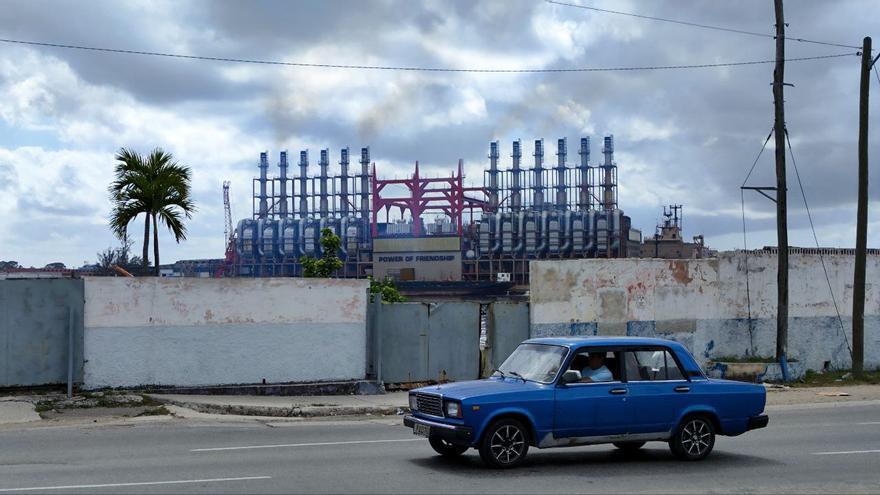
![]() 14ymedio, Havana 13 February 2024 — The generation deficit predicted by the Electric Union (UNE) broke a new record on Tuesday, with the announcement that 1,308 megawatts (MW) and up to 1,378 MW at peak hours will be missing. Cubans already know what that means: the climax of the energetic debacle after several weeks of blackouts, despite being in the coolest season of the year. Complaints have erupted on the company’s social networks.
14ymedio, Havana 13 February 2024 — The generation deficit predicted by the Electric Union (UNE) broke a new record on Tuesday, with the announcement that 1,308 megawatts (MW) and up to 1,378 MW at peak hours will be missing. Cubans already know what that means: the climax of the energetic debacle after several weeks of blackouts, despite being in the coolest season of the year. Complaints have erupted on the company’s social networks.
According to the UNE, unit 2 of the Felton thermoelectric plant, in Holguín, and unit 5 of Renté, in Santiago de Cuba, are out of service due to a breakdown. Likewise, unit 8 of Mariel (Artemisa), unit 3 of Santa Cruz (Mayabeque) and unit 4 of Cienfuegos are under maintenance.
During peak hours, the company says, four generators of the Turkish patana [floating power plant] of Melones, located in Havana Bay, with 65 MW and 27 MW respectively, will come online. The system relies on these generators, but the sum does not even cover the deficit in thermal generation, which amounts to 338 MW.
On the UNE Facebook page, users do not let up on the company, which “every day (announces) less generation availability”
On the UNE Facebook page, users do not let up on the company, which “every day (announces) less generation availability,” with forecasts that fall short in the face of reality. This was the case on Monday, when the UNE reported a deficit of 1,033 MW that became 1,183 MW. “San Antonio de los Baños, as always, was at the forefront, from 8 pm to 12 am, and at 5 am we began the cycle again and are still waiting,” complained a netizen from Artemisa, alluding to the intense day of blackouts on Monday.
Residents in Granma, Holguín, Matanzas and Las Tunas provinces made similar claims and pointed out that “all of Cuba (is) turned off with the exception of the capital,” a complaint that has been spread among those who complain to the UNE that Havana is privileged while the rest of the country suffers up to 12 hours without electricity.
Other commentators, more sarcastic, announced the collapse of their plans for the celebration of Valentine’s Day on February 14 due to the blackouts. “They are going to give us a tremendous gift for the day of love and friendship,” said a reader.
The fuel crisis, with which the authorities justify everything from power cuts to the absence of food in the warehouses, was recently refuted by the British agency Reuters. With data provided from Venezuela and the monitoring of the transfer of oil ships to the Island, Reuters says that the amount of oil that passes through Cuba is more than enough to meet the demand.
According to the National Bureau of Statistics and Information, Cuba needs about 125,000 barrels per day (bpd) of fuel for electricity generation, gasoline and diesel. The country “has a constant national oil production of around 40,000 bpd that is used mostly for power generation, and it receives 56,000 bpd of crude oil and finished fuel from Venezuela, according to ship monitoring data provided by LSEG and documents from that country’s state company, PDVSA,” Reuters analyzes.
If to this is added the arrival of the 23,000 bpd from Mexico and another 10,000 bpd purchased from European countries, the Island would be receiving up to 129,000 bpd
If to this is added the arrival of the 23,000 bpd from Mexico and another 10,000 bpd purchased from European countries, the Island would be receiving up to 129,000 bpd, that is, 4,000 bpd more than its total consumption according to official data. The causes of the “alleged crisis” should be sought then, explains Reuters, in the failures of the infrastructure and internal logistics, as the expert from the University of Texas Jorge Piñón points out: of the three refineries in the country, only the one in Cienfuegos works, while those of Havana and Santiago de Cuba are shut down due to technical problems.
These problems are aggravated by the loss of hydrocarbon storage as a result of the destruction of the Matanzas supertanker base by the 2022 fire, which forces the distribution of the loads at several points on the island and on the ships themselves, until they can enter the refinery and be distributed.
Meanwhile, oil tankers continue to arrive in Cuba, including the Sea Hermes I, the Caribbean Alliance, the Sandino and the Pluto, which were reported this Tuesday in several ports, in addition to the Aquila and the Eco Fleet, announced for the coming days.
Translated by Regina Anavy
_______________
COLLABORATE WITH OUR WORK: The 14ymedio team is committed to practicing serious journalism that reflects Cuba’s reality in all its depth. Thank you for joining us on this long journey. We invite you to continue supporting us by becoming a member of 14ymedio now. Together we can continue transforming journalism in Cuba.
